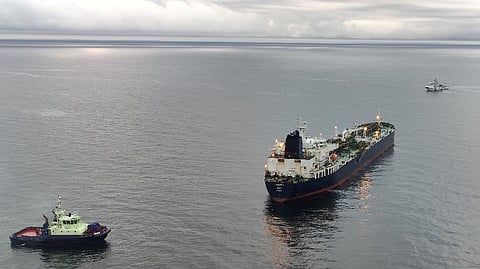

The recent surge in suspected Russian “hybrid warfare” incidents across Europe has put governments on high alert, raising concerns about the vulnerability of the region’s energy infrastructure as the continent enters the critical winter heating season.
Preventing sabotage of such an extensive energy network poses major security and logistical challenges, but European leaders may soon need to take additional precautions.
With temperatures set to fall, the region has seen an increase in so-called hybrid warfare — aggressive actions such as airspace violations — widely believed to be linked to Russia. These activities threaten Europe’s security but have so far stopped short of provoking a NATO military response, as Moscow denies involvement.
European governments have blamed Russia for a wave of drone incursions in recent weeks, including incidents that caused airport disruptions in Denmark and Norway. Drones were also spotted over Danish North Sea oilfields in September, while Poland shot down suspected drones that entered its airspace on September 10. Ten days later, Russian military jets violated Estonian airspace.
Since the first incursion of 20 Russian drones into Poland on September 9, northern European NATO states have recorded at least 38 additional incidents spanning Scandinavia, Belgium, and the Baltic states, according to the Washington-based Center for European Policy Analysis.
Beyond drones, recent incidents have included suspected ship navigation system jamming, cyberattacks, and sabotage targeting infrastructure across Europe. While Moscow has denied any role, reports indicate that some aircraft were launched from Russian tankers off Europe’s coastlines.
Energy vulnerability
So far, the latest hybrid attacks have not directly targeted Europe’s vast energy infrastructure, which includes thousands of kilometres of pipelines, power cables, LNG terminals, oil and gas fields, and renewable energy sites.
However, the rise in incursions comes as Russia and Ukraine intensify direct strikes on each other’s energy facilities. Ukrainian drone attacks on Russian refineries have caused fuel shortages, while Russia has recently launched large-scale strikes on Ukraine’s gas production sites.
Given this context, Europe’s energy networks appear a likely target for future hybrid attacks. Energy supply and demand are delicately balanced entering winter, leaving the continent exposed to any disruption that could trigger price spikes and higher heating costs.
Hybrid attacks on European energy systems are not unprecedented. On Christmas Day 2024, the Russian-linked tanker Eagle S dragged its anchor across the Gulf of Finland, severing the Estlink-2 power cable between Finland and Estonia, prompting a national emergency. A year earlier, a vessel sailing from Russia damaged the Balticconnector gas pipeline between the two countries.
Cyberattacks have also emerged as a growing concern. On the day of Russia’s invasion of Ukraine in 2022, a cyberattack on ViaSat disrupted operations at German wind turbine firm Enercon, cutting off remote monitoring access to more than 5,800 turbines. British and US intelligence services attributed the attack to Russia.
Unprepared
The question now is whether Europe is ready for future hybrid assaults on its energy systems. The likely answer: not yet. NATO and the EU have stepped up defensive measures, including the Baltic Sentry naval initiative and plans for a “drone wall” along the bloc’s eastern border.
“There has definitely been increased effort to prop up defensive and protection measures, especially in the physical gas and power infrastructure sectors around the Baltic and Scandinavian regions,” said Henning Gloystein, Managing Director of Energy, Industry, and Resources at Eurasia Group. “But there are still some shortfalls.”
Given that continuous surveillance of Europe’s vast energy network is impossible, diversification may be the key. Governments and companies could strengthen resilience by building backup gas systems, investing in local renewable plants and storage facilities, and expanding strategic gas reserves.
Europe’s energy markets managed to adapt after Russia’s 2022 invasion of Ukraine by replacing Russian pipeline gas with imported LNG — but at great economic cost.
Russian hybrid warfare now poses a fresh threat that could cause serious hardship for European households if attacks target energy systems during the coming winter. Addressing this challenge will require unprecedented coordination — and significant spending — by both governments and the private sector.
But time is running short. Winter is coming.
(Ron Bousso; Editing by Rod Nickel, Reuters)
